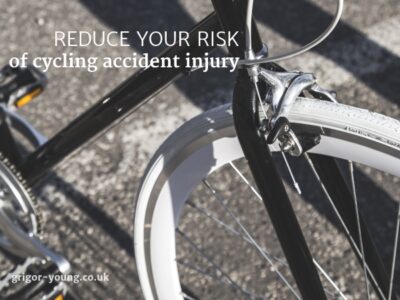When the clocks have gone back and the nights are fair drawing in, riding a bicycle involves greater risk than it does during the long daylight hours of Summer.
Even so, there are many things you can do to maximise your safety when out on your bike.
Some people insist that high visibility jackets and cycle helmets are essential clothing for cyclists. On the other hand, there are those who maintain that such alleged safety measures make little or no difference to your risk of injury.
What does the law require by way of bicycle accident safety precautions?
The Highway Code
Rule 59 of the Highway Code says you should:
- wear a cycle helmet which accords with current regulations. It should be the right size and fastened securely.
- have suitable clothing for cycling – i.e. avoiding loose clothing which could become entangled in part of the mechanism or obscure the lights.
- dress in light colours, so as to improve your visibility to other road users – fluorescent or reflective clothing and/or accessories are best.
Rules relating to cycling come up again later in the Highway Code, at Annex 1. The requirements here include:
- having efficient brakes; and
- during the hours of darkness, as well as having a red rear reflector, using front and rear lights.
This section, however, does not make any mention of cycle helmets.
Research on the safety benefits of cycle helmets
The Transport Research Laboratory (TRL) has carried out research into whether cycle helmets reduce the frequency and severity of injury in the event of a collision.
They pointed out that not all accidents to cyclists involved collisions with other vehicles. The most common accidents not involving a collision with another vehicle were simple falls or being thrown over the handlebars.
Cycle helmets would be expected to be effective in that type of scenario and also where the accident mechanism involved a glancing blow from another vehicle, causing the cyclist to tip over and strike their head on the ground.
TRL established that in most accidents where the cyclist sustained serious head injuries, a cycle helmet would have had a beneficial effect. In TRL’s assessment, cycle helmets have the potential to prevent a fatal head injury at speeds of up to 15 mph.
No legal requirement to wear a cycle helmet
As the law stands, the decision whether or not to wear a cycle helmet is yours alone.
In another article, we have looked at the possibility of contributory negligence applying to a non-helmet-wearing cyclist. In theory, contributory negligence is possible. We can say that by analogy with ‘seatbelt cases’. Front seat vehicle occupants who failed to wear a seatbelt had their compensation reduced for contributory negligence even before it became a legal requirement to wear front seatbelts from 1983 onwards.
Wearing a cycle helmet makes sense
While a cycle helmet will not make much difference to the extent of your injuries in a high speed collision with another vehicle, it makes sense to wear one for the significant injury protection benefit it provides at “cycling” speeds.
If you fall off your bike due to lack of attention or because you hit the brakes too hard and go over the handlebars, you probably won’t be able to claim compensation for your injuries. At least you will have the consolation of your helmet minimising any head injury – possibly making the difference between concussion and permanent brain injury, or worse.
How we can help
For more information about this article or any aspect of our accident and injury claims services, please call us on 01343 544077 or send us a Free Online Enquiry. We will be glad to help you.
There is no charge for initial enquiries / telephone discussions.
Header Image: A view north west from the cycle path between Elgin and Lossiemouth.
Post Image: Original image by Milada Vigerova via Unsplash.


 How To Find A Local Specialist Solicitor In Scotland
How To Find A Local Specialist Solicitor In Scotland